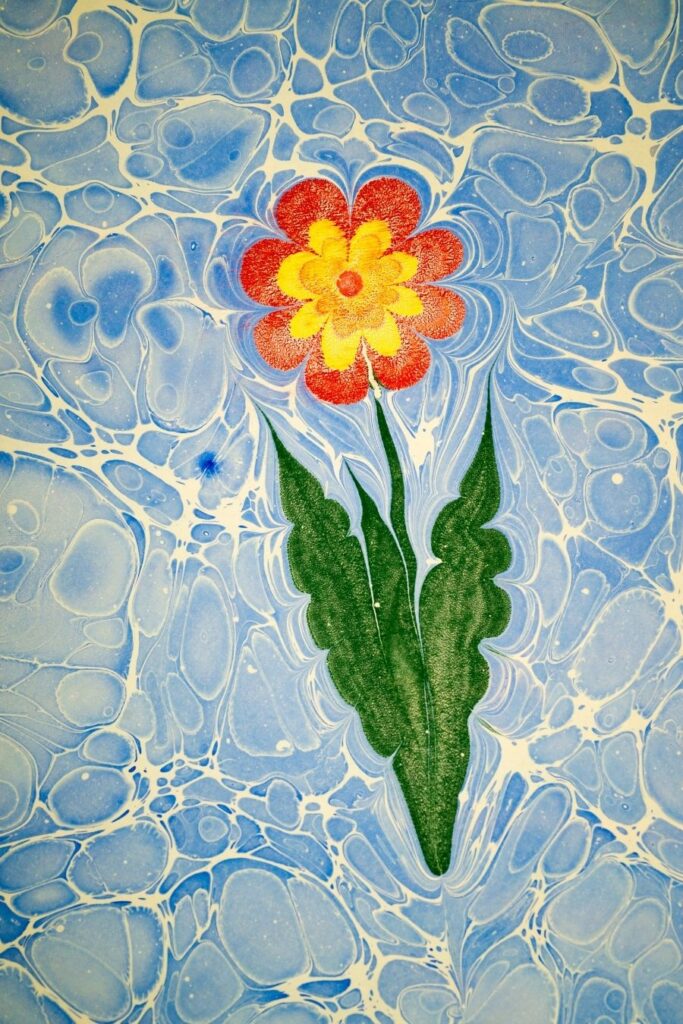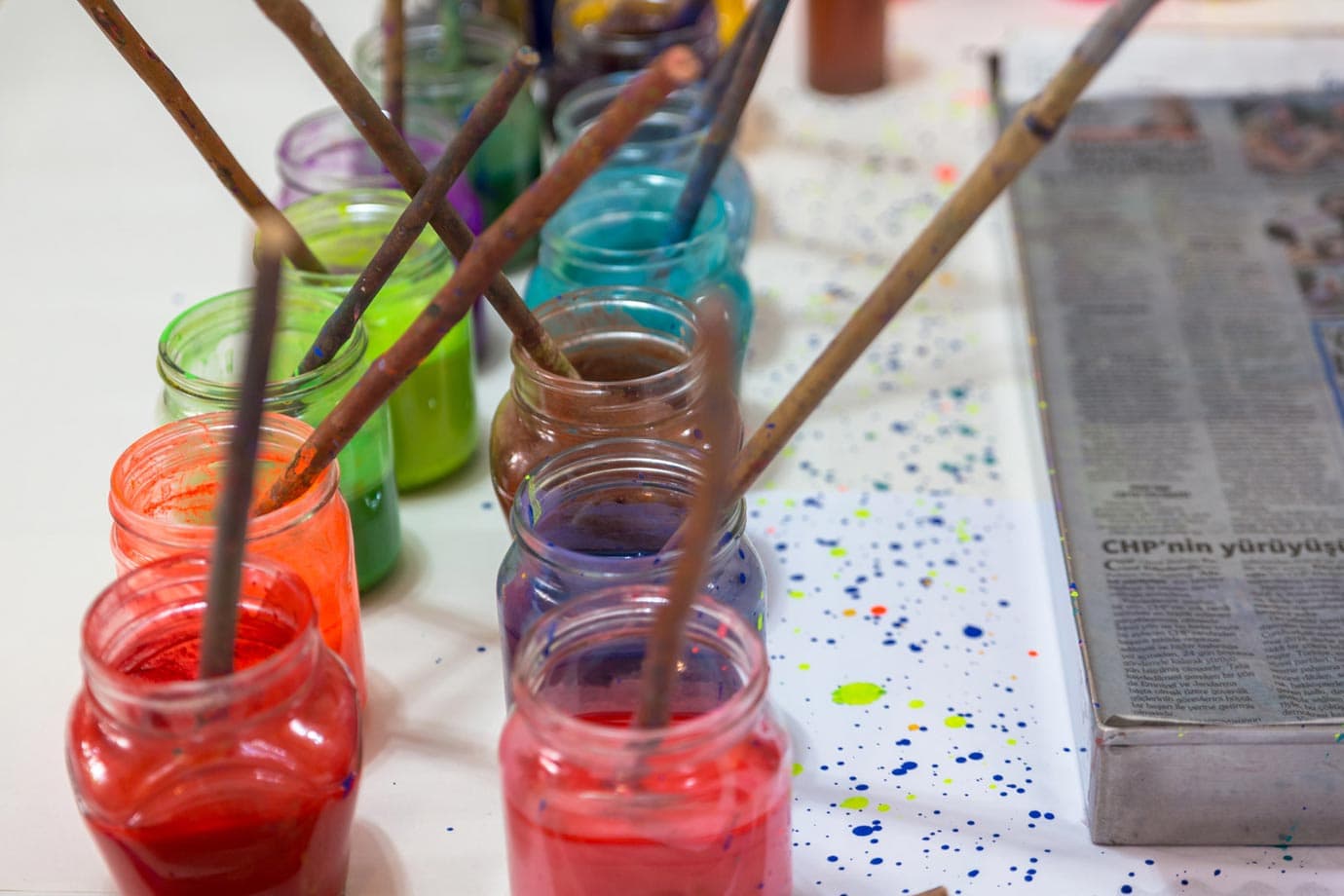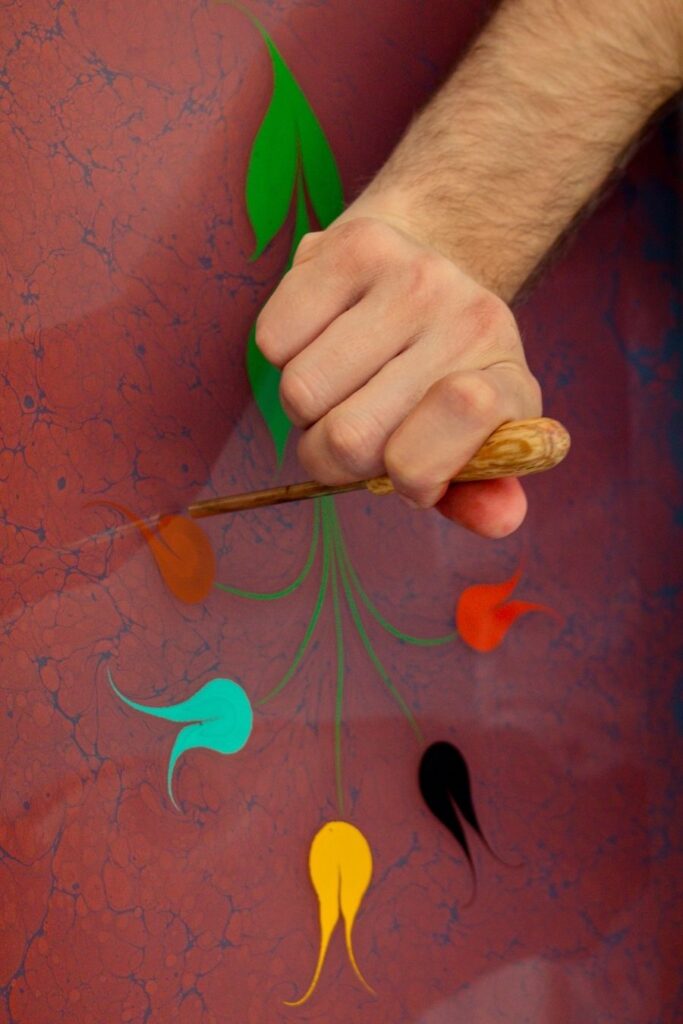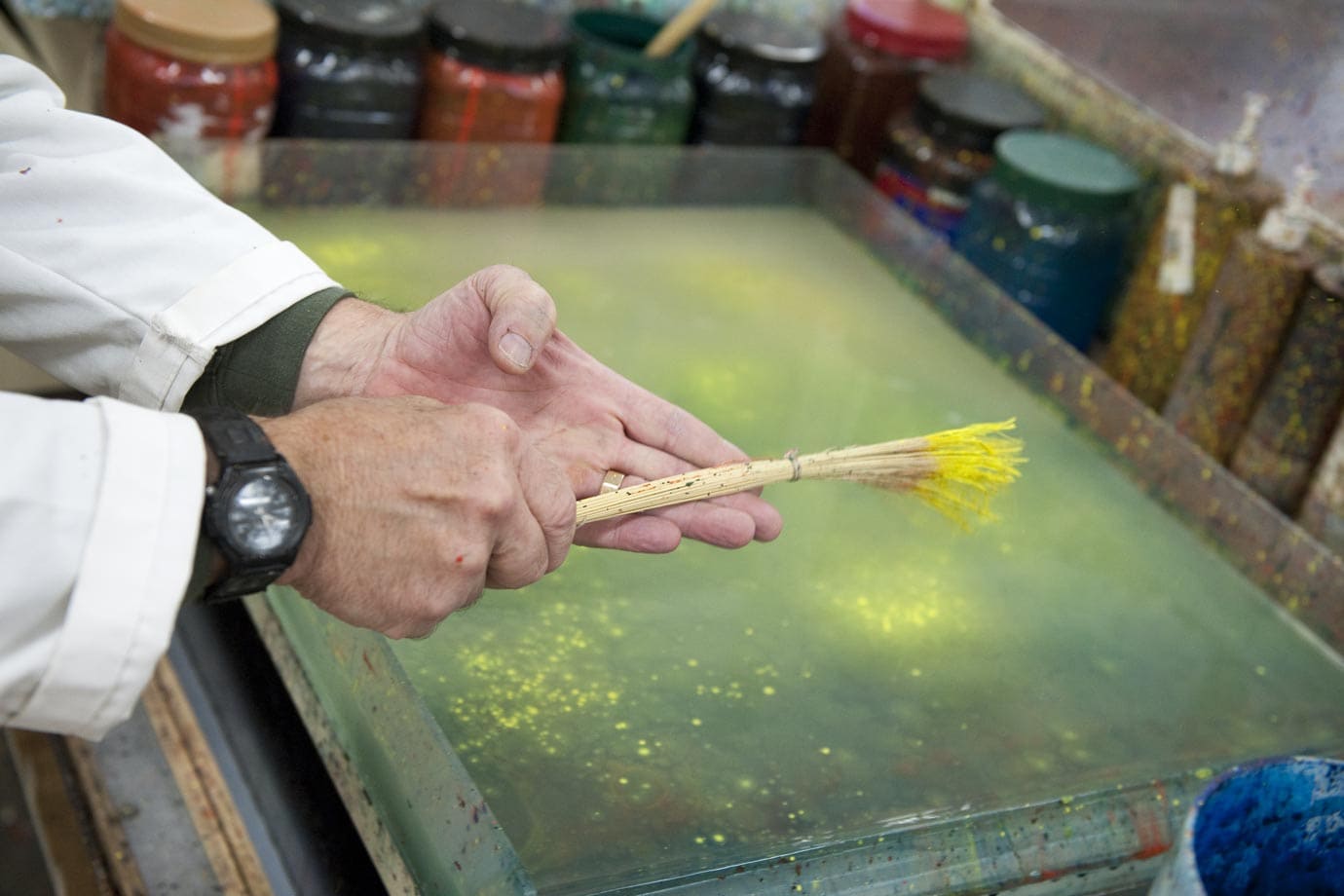This post contains product affiliate links. These are mainly on items/hotels/tours that I personally endorse & love. I may earn a small commission if you make a purchase, but at no extra cost to you.
What is ebru? Also known as paper marbling, it is the Turkish tradition of painting on water. This is how the ancient ebru marbling art is done!

One of the questions I always get asked about one of my experiences in Turkey is “what is ebru?” Until I went to Istanbul, I had no idea ebru art even existed!
Well, to put it bluntly, ebru is one of the most bizarre forms of painting I’ve ever come across. When done right, it is utterly beautiful though.
If I hadn’t done it myself, I would’ve thought painting on water would have been impossible, but the ancient art of ebru has not only survived for centuries, it thrives in Turkey.

Let me say this now – I am disastrous at art. I was once told by my art teacher that if I took an art class and tried really really hard I might just pass with the worst grade possible. And that was my art career over aged 14.
When I found out that I’d be learning how to do ebru, the art of paper marbling, I didn’t hold out much hope that I’d be any good. The results? Jackson Pollock eat your heart out. I was so surprised that this marbling art was relatively easy AND it looked good.
If you’re interested in learning more about water painting yourself, check out this incredible ebru workshop in Istanbul. Here you’ll get to practice water painting and even take one home as a souvenir. I would say this is a fantastic family activity with the kids too, so check it out!
Travelling around Turkey? Then check out my guides to kayaking at Kekova, sailing a gulet in Göcek, and eating my way though Istanbul.
Contents:
What is ebru?
Ebru, also known as paper marbling, is a Turkish art from Central Asia that dates back to the Ottoman empire at the beginning of the 16th century.
It is an art form where you paint directly on the surface of water in a shallow tray. Once you’ve finished your design, you place a sheet of paper on the surface to transfer the design from the water onto the paper. The process sounds simple, and in practice it is, but the results are hard to master. Some ebru artists will paint for decades before they’re regarded as true masters of the art.
Back in the Ottoman Empire, the Ottomans used ebru to decorate the spines of books with intricate and colourful designs. Not only was this decorative, it was it was also used as a type of code. If the pattern on the spine was broken then you’d know some pages were missing from the book and someone had intercepted the message. How clever is that!?

Paper marbling supplies – what do you need?
When talking about it, ebru can sound a little bit gruesome.
Because everything is so traditional in Turkey, ebru uses the same techniques as centuries ago. Nothing has really changed. This means that ox gall bile is added to the water to prevent the paints from all sticking together (I’m sure 99% of you have never smelled ox gall bile before but it stinks).
Also, some of the colours like the ruby red are made from boiling beetle wings and then grinding it down into a powder. You see, I said it was gruesome!
Obviously this is the very traditional way of ebru painting.
Today, there are some more animal-friendly alternatives. For example, photographic wetting agent can be used instead of ox gall bile. Another substitute is washing up detergent or dish soap – this spreads the paint soultion out on the surface of the water.
For the paints, you can use any type of acrylic paint that doesn’t use or harm animals. As I said though, if you’re doing this in Turkey, it’s likely they’ll stick to the traditional method for ebru.

Paper marbling techniques
While I was in Istanbul with Lonely Planet, we wanted to find those local stories and those traditions you can’t find anywhere else in the world. That’s why I found myself at Mehmet Önal’s house, to learn ebru straight from the master.
Mehmet learned ebru from his dad and grandad, and he’s been practicing ebru for the last 60 years. He’s really perfect his ebru technique over the decades.
Not only that, but his daughter Nazan and granddaughter Sera are also ebru artists, so this really is a family tradition.

It was actually Nazan who taught me the finer details of ebru.
The first thing you do is choose your base colours – these are the ones that create this beautiful marbling effect – and with two fingers you tap the brush to splatter the paint over the surface of the water. If you want big dots, you hold the brush closer to the water. If you want tiny dots, you hold it further away from the water.
Then, once your base layer is done, it is time to start creating a design. Because drawing on the surface of water is difficult, it is all very abstract. Most designs are of animals, flowers and stars, but it really is only limited by your imagination!

What is Turkish marbling art?
What I loved about ebru is you can create beautiful brightly coloured designs fairly easily. I mean, I felt like the stuff I created was half-decent, and that’s really saying something.
Also, it’s all very interpretive. There’s definitely no right or wrong way with ebru – you just choose the colours you want to paint with, splash them on the water and then try and create something stunning.
I felt its beauty was in its simplicity. This is an ancient tradition that’s been passed from father to son, from mother to daughter, for centuries. I found it best to stick to the traditional patterns as much as I could to really respect this style of art.

After trying a few designs where I was let loose with my imagination, it was time for my final test to put into practice what I had learned over the day.
For this I was back in the hands of Mehmet.
Watching his every movement, I watched him create this ornate bunch of roses on a paper marble background. I think it had about nine different steps in total and I lost track of it all around step four.
Obviously I was set up to fail – that’s why we had a camera crew with us – but I think everyone was more than a little bit surprised with the final results. I mean, it wasn’t good by any stretch of the imagination, but you could tell it was a bunch of flowers, so in that respect I think I did well.

Trying ebru art for beginners
The thing about ebru is it really puts you in the moment. From flicking the paint to drawing on the surface of the water, it requires you to really concentrate on what you’re doing. Because of that it’s incredibly calming and therapeutic. All that matters is that moment, and I love that.

I have to admit it was incredibly humbling learning the ancient art of ebru marbling from this family who were so keen to impart their knowledge onto me. I just hope I didn’t let them down.
It’s not every day you get to practice something such as ebru, and after 17 years it’s nice to prove to my art teacher that perhaps I can do art after all. You know, in an abstract kinda way.
Photos of paper marbling






My trip to Turkey was in association with Lonely Planet and Turkey Tourism uncovering some of the best things to do in the country. As always, views are entirely my own and without bias.
Have you ever tried ebru or paper marbling before? If not, is it something you’d like to try? I would love to hear your thoughts so let me know in the comments below!
Like this blog post? Then make sure you Pin it!



Ebru looks n sounds fascinating! I would do love to learn.
Yeah it’s amazing! It’s such a unique activity to do, especially in Turkey.
Hi – what ratio would I use if I want to make it stick to fabric using acrylic paint and dish soap? Or is there something better?
I’m not entirely sure of the rations I’m afraid Melissa. I just took the class, so I don’t know the ins and outs of it. I’m definitely not an ebru master that’s for sure!
I want to learn this kind of art, I’m a hurry person. I wish to learn something that calms me down, especially my age of 50
Ebru would be great for mindfulness and meditation. You really immerse yourself in the art and only concentrate on what’s in front of you. If you’re looking for something to calm you down, this is a great activity.
Hi Macca!
I knew this beautiful art in Paris, there is just one person that’s show you this art here in Paris, but just that, because I wanted to start learning more, I bought all the materials from Estambul that sent to me, but my problem was the mix the paint with ox gail, it doesn’t make the buble grow or sometimes gets down.
Could you please let me know the exact measurements of the mixture of the paint with the ox gail and the proportions of water with the kitre.
Thank you very much!!!
Good question! I’m not quite sure of the measurements – we didn’t measure it out. Instead, it was just a few good squirts of the bile, so I would say 50-100ml would be a good start. Hopefully you can work it out through a bit of trial and error though as that’s what I did on my course!
’cause Acrylic paints are so traditional
Lol
Thanks for sharing this experience, but as a doctoral candidate documenting the early history of this art, I must make a few comments and corrections:
1) This art form is known as “abri” meaning “clouded” or “cloudy” paper in Persian in more than 80 sources written in not only that language but also in Ottoman and Chagatai and Urdu languages. In contrast, the cognate “ebru” is only documented as of 1831. Many in Turkey will insist that the term ebru is of purely Turkic origin, but there is no proof to support that assertion, and there is quite of lot evidence proving it is a corruption of the Persia term.
2) Similarly, paper marbling is not only practised in Turkey but also in Greater Iran and the Indian Subcontinent (only the term “ebru” is not known in those regions). It is interesting that the phrase “paper marbling” has been documented in English for far longer than the word “ebru” has been used in Turkey.
3) The solution on which the colors are floated is generally a viscous liquid, not just water, which in Turkey is generally thickened with gum tragacanth. Other approaches are also historically documented
4) The 16th century is generally not regarded as “ancient” but “early modern.” Nevertheless, I am thankful you posted an accurate date, as there is a lot of unsubstantiated hyperbole about it being “ancient” and practiced “2,000 years ago” but there is no evidence to support such assertions.
5) Technically speaking, the spines of books were never marbled (they were usually covered in leather or cloth), but the edges of the texts of European-style books were. The notion that the edges of account books were marbled to deter tampering with them is a popular concept, but unfortunately, there is no evidence to prove that it is true. All surviving references indicate it was done to prevent the soiling of the edges of heavily-used books such as stationery bindings, registers, daybooks, and account books. Furthermore, that particular adaptation was not actually practised historically in the Ottoman mpire, but emerged in Europe. It later arrived in Turkey in the 19th century as part of accounting reforms instituted during the Tanzimat. In an article out in the next issue of the American Journal of Numismatics, 31, I am publishing an essay on the historical practice of security marbling, together with a brief overview of the early history of this art in light of recently-discovered evidence.
6) Recently-discovered evidence demonstrates technical advancements in this art form were innovations of a little-known Persian master named Muhammad Tahir, an émigré to India—probably to the Deccan Sultanates—by circa 1600. His methods rapidly travelled from India to Iran, Turkey, and Europea in about 20 years’ time.
To learn more, you can refer to papers posted to my Academia.edu page: . Specifically, you might like to review my contribution to the 2015 Metropolitan Museum exhibition “Sultans of Deccan India, 1500–1700: Opulence and Fantasy.” My dissertation should be completed next year.
Jake Benson
Ph.D. Candidate
Leiden Institute for Area Studies
Leiden University
Thank you so much for taking the time to comment Jake, I really appreciate it. You’ve packed in so much information that I’m sure people will find really useful when learning about ebru. Thanks again!
Hi Macca! I watched paper marbling videos before but didn’t know the name. It’s very creative and interesting. I would love to learn Ebru. Can you please help me through this? Thanks.
Zeenat
Hi Zeenat! I’m not too sure I’m the best person I’m afraid – I’ve only done it once! If you’re heading to Istanbul there are a few classes you can take there. It’s an amazing art and I really recommend it!
Hi! I am visiting Istanbul this next saturday. I have read you post and I also watched the video about ebru at the Lonely Planet website, It just make me wanna try it too! I wonder whether you could recommend any experience in Istanbul similar to the one you had with Mehmet Onal’s family, where you could actually learn how to marble paint like them (of course if they offered this kinf of activity for travellers would be great!) Many thanks in advance! Júlia A.
Hi Julia! I’ve just seen your message – how did you get on in Istanbul? Did you enjoy the city? And did you get to try ebru? I’d love to know what you thought of the experience!